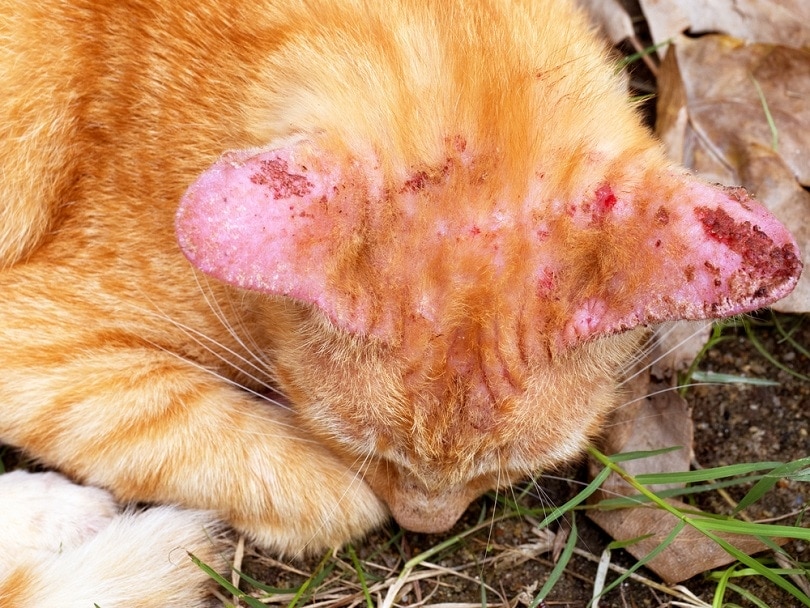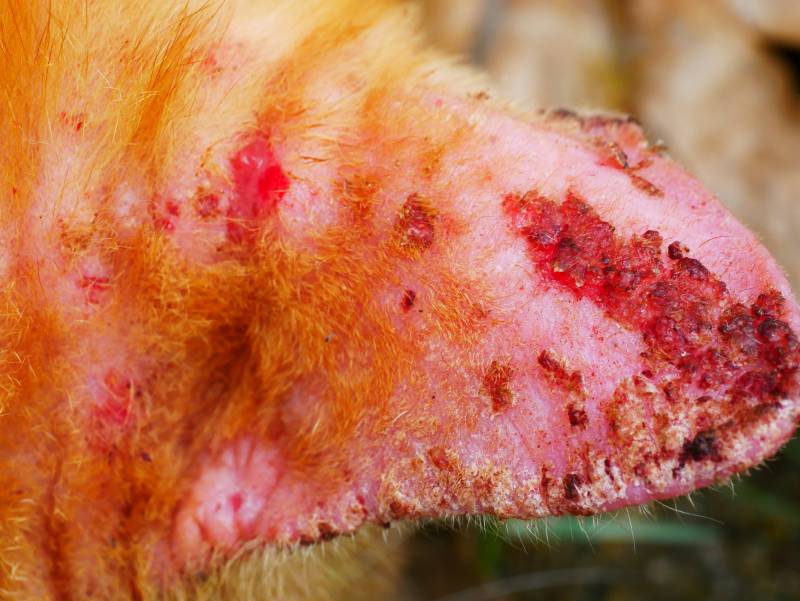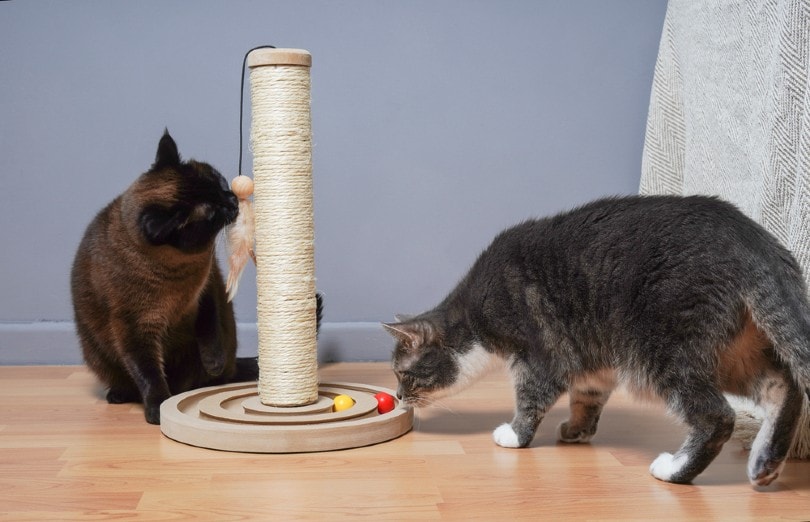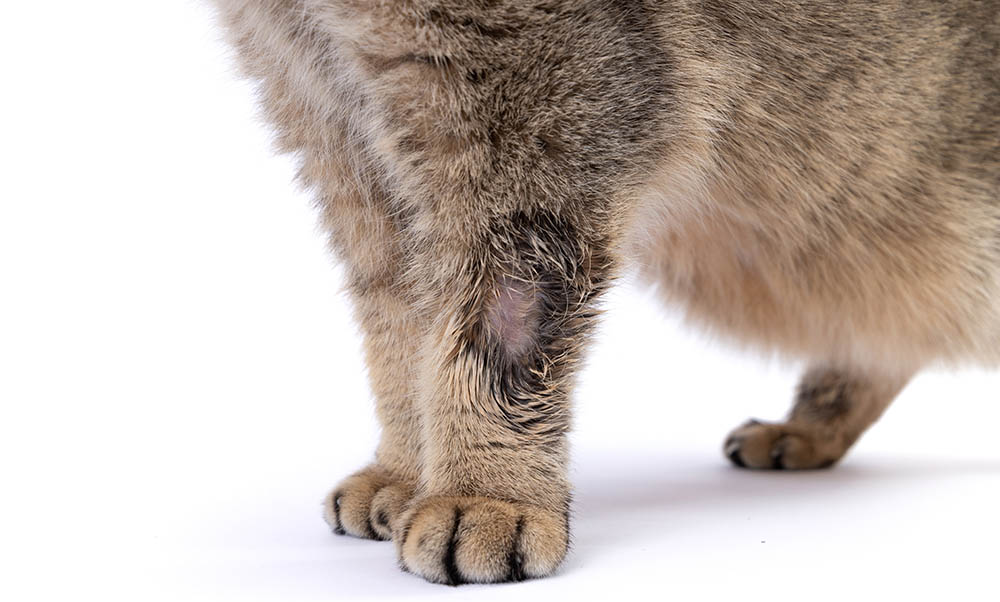
Ringworm is not a worm or even an invertebrate. It’s a fungal infection of the skin and was named after its appearance in humans, as it tends to look red and scaly and have a ring-shaped form. Some cats may show no signs at all, while others may have bald spots and hair loss across their body, though not always in a ring-like pattern. Feline ringworm is contagious to humans, so you must exercise caution when a ringworm-positive cat is in your household.

What Is Ringworm?
Ringworm is a generalized term given to a fungal infection of the skin, hair, and claws. The fungi responsible for ringworm belong to a group of organisms known as dermatophytes1. Dermatophytosis is the medical term used to describe the superficial fungal infection of the skin. Dermatophytes not only feed on the dead outer layers of the skin, known as keratin, but also infect hair and claws, which are made of the same protein. Some dermatophytes are species-specific, meaning they only infect one species of animal. Others can spread to multiple animals across a wide range of species, including humans. The most common species of ringworm found in cats, Microsporum canis, can also be transmitted to dogs and people2. When a disease can be transmitted from an animal to a person or vice versa, it is referred to as zoonotic or zoonosis.

What Are the Signs of Ringworm?
Ringworm lesions are not always ring shaped in cats, and some cases may be mild and show no signs at all. The skin lesions usually appear scaly or crusty, with hair loss or bald patches most commonly located on the head, chest, forelegs, and along the top of the spine. More generalized infections may present as hair loss or alopecia over a larger area of the body. Occasionally, ringworm may infect their claws, producing signs such as pitting, roughness, and scaling of the skin along the nail base, which may lead to malformation of the claws. Persian cats with ringworm are prone to developing bumpy lesions or nodules on their skin3.
What Are the Causes of Ringworm?
Ringworm can be passed along to a new host through direct contact with the fungus, which can be from an infected animal or person, or by touching contaminated objects and surfaces. Ringworm spores are rather hardy in the environment and may lie dormant for up to 18 months at a time. Common household objects that may be contaminated with fungal spores from an infected cat include brushes, food bowls, furniture, and toys. Some cats, including those with long coats, may remain asymptomatic (without signs) but can still pass the fungus on to others.
Not all exposures result in infection, however, and are largely based on the amount of spore contamination in the environment and the age and immune status of individuals. Microtrauma to the skin and moisture on the skin often predispose cats to spore infection. A high concentration of cats living in a single area, cats in warm and humid climates, kittens and older cats, outdoor cats, and those with depressed immune systems are more at risk of infection. The incubation period, which is the time from exposure to clinical signs of the disease, can range from 7 to 14 days and up to 3–4 weeks in some cases after initial contact with the fungus.

How Do I Care for a Cat With Ringworm?
Your veterinarian will perform a complete physical examination of your cat, paying special attention to the skin and coat. In a dark room, a Wood’s lamp, which emits ultraviolet light, may be used to look for the characteristic yellow-green glow or fluorescence that some ringworm species emit, including M. canis. The Wood’s lamp is carefully passed over your cat’s hair to look for any glowing areas. Only the hair shafts glow. If a glowing area is found, it strongly suggests the presence of fungal spores. Not all species of ringworm glow, however, so additional tests may be needed to diagnose a fungal infection.
Your veterinarian may pluck samples of hair and scrape the surface of lesions to look for fungal hyphae and spores under a microscope. A new, unused toothbrush may be used to gently brush and scrape the skin surface of ringworm lesions to try to culture on a fungal plate. Direct examination of scale and hair under a microscope can diagnose infection in greater than 85% of cases. Culturing dermatophytes from hair and skin samples is one of the most accurate ways to diagnose ringworm infections. A positive fungal culture may take anywhere from a few days to up to 3 weeks, depending upon the growth rate of the spores.
A sample may be sent for polymerase chain reaction (PCR) testing, which confirms the presence of fungal DNA, but it cannot distinguish between living and non-living spores. This test is quicker than culturing spores, with results in 1 to 3 days. Your veterinarian may want to biopsy a suspicious skin lesion or nodule on your cat to look for fungal spores or rule out other skin issues, though this method is not typically used in routine ringworm cases.

Once a test comes back positive for ringworm, your veterinarian will offer treatment options. In healthy animals, ringworm infections are usually self-limiting and do not need treatment, but it’s still recommended to speed healing and minimize spread. Treatment usually consists of topical and systemic therapies used in combination for effectiveness. Topical therapies may include creams, ointments, shampoos, or dips. Creams and ointments are applied directly to affected areas and may need to be used for several weeks to months to clear the infection. Cats may be bathed with anti-fungal shampoos or given lime sulfur dips twice weekly for several weeks until the infection resolves. Hair may be shaved over individual ringworm lesions if only a few are present, but cats with generalized ringworm infections may need a full body shave, as this allows for better contact with the topical therapies.
Treatment requires patience and usually lasts a minimum of 6 weeks, but it may take longer in some cases, depending on the individual cat and their response to therapy. Infected cats may remain contagious for approximately 3 weeks to other cats, dogs, and people, even with aggressive therapy. Minimizing exposure to other pets and people is crucial during this time. All treatments need to be completed as prescribed by your veterinarian because ringworm can return if medications are not given as directed or are stopped early. Fungal cultures are repeated several times after starting therapy to ensure the effectiveness of the medications. One negative PCR test and/or one negative fungal culture suggests that treatment was a success in otherwise healthy cats. Two negative fungal cultures 2 to 4 weeks apart signify that treatment was successful in cats with systemic illness.
Commonly prescribed topical therapies include:
Oral systemic medications include:
Itraconazole is an oral systemic anti-fungal medication that is well tolerated in cats without being toxic to their liver or causing inflammation of their blood vessels (vasculitis). Ketoconazole is another oral anti-fungal medication, but it should not be used in cats because it can cause anorexia.
Since ringworm is contagious to other cats, dogs, and people, you must thoroughly clean the environment, surfaces, and objects that your ringworm-positive cat has touched. Infected hairs and dandruff from your cat contain ringworm spores that may persist in the environment for up to 18 months and are infectious during this time. If the environment is not also treated, ringworm infections can recur.
A convenient way to control infection is to contain your cat in a room or a part of your home that is easy to clean. Thoroughly vacuum and mop all areas that are accessible to your cat at least once or twice a week. Wipe all surfaces to remove organic material between cleanings. A detergent or diluted bleach solution of 16 fluid ounces of chlorine bleach to 1 gallon of water is sufficient to kill spores. Bedding can be disinfected by washing it, and carpets can be decontaminated by shampooing or steaming.

Frequently Asked Questions (FAQ)
How Is Ringworm Transmitted?
Ringworm is transmitted through direct contact with an infected cat or by touching contaminated surfaces and objects. Ringworm spores often cause disease in immunocompromised individuals and typically require microtrauma or moisture on the skin to establish infection.

Does Ringworm Look the Same in All Cats?
No, not all cats will show signs of ringworm. Some cats, especially those with long coats, may not have any outward signs of ringworm, but they can still have the fungus and transmit it to other cats, dogs, and people.

Conclusion
Ringworm is a skin infection of cats caused by a fungus that can be contagious to other cats, dogs, and people. Some cats may not show any signs of the disease, while others may have hair loss, itching, and scaling of the skin. Diagnosis is usually made by using a Wood’s lamp, observing fungal spores from skin scrapings and hair pluckings under a microscope, and by culturing spores on a plate. Treatment may consist of topical and oral therapy, along with environmental cleaning to prevent the spread of ringworm.
Featured Image Credit: Ameena Matcha, Shutterstock







